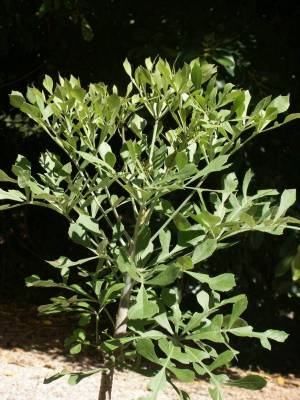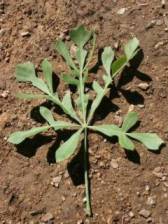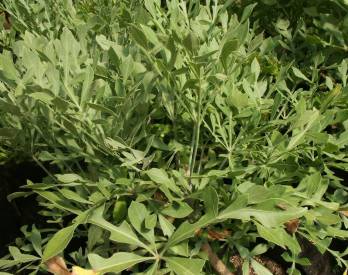Cussonia transvaalensis
Cussonia transvaalensis Reyneke
Family: Araliaceae
Common names: grey cabbage tree (Eng.); vaal kiepersol (Afr.); motshetshe (Northern Sotho)
SA Tree No: 564.3
Introduction
Cussonia transvaalensis is a striking, very useful tree as a focal point in the landscape, due to its strong architectural form; it may also be used to good effect in a container while still young.

Description
Description

Small to medium-sized tree up to 5 m, with attractive, coarsely textured grey-green foliage. The bark is corky and deeply longitudinally fissured. The small, green flowers are borne in dense finger-like structures and pollinated by insects, followed by the production of small, purple-black berries, which are relished by many species of fruit-eating birds.
Distribution and habitat
Distribution description
The grey cabbage tree is distributed over the Transvaal Drakensberg escarpment in Mpumalanga and Limpopo provinces; it also occurs in the Waterberg as well as isolated places in the North-West and Gauteng provinces. It occurs on rocky slopes in hot, dry, wooded savannah.
Derivation of name and historical aspects
History
The genus Cussonia was named after the Professor of Botany at the University of Montpellier, Prof. Pierre Cusson (1727-1783). The specific name transvaalensis refers to the old Transvaal province, the region in which the species occurred. This species was only named by science in 1984.
The genus Cussonia is small and occurs in Africa and the Mascarene Islands. There are eleven species in South Africa of which most are small to medium trees. The large, well-known family Araliaceae contains well-known plants such as ginseng, ivy, and several indoor plants, as well as Tetrapanax papyiferus, which is used to make Chinese rice paper. It is also closely related to the parsley family, Apiaceae, to which belong several popular vegetables and herbs such as carrots, fennel and parsley. Other species which are grown in gardens include Cussonia paniculata and Cussonia spicata.
Uses
Use
The roots are succulent and edible; mashed roots have been used in the treatment of malaria. The wood is soft and was historically used for the manufacture of brake-blocks for ox-wagons.

Growing Cussonia transvaalensis
Grow
The grey cabbage tree is relatively easily cultivated, but does not tolerate extreme frost. It is highly desirable as an accent plant in the landscape or as a sculptural individual specimen placed in the ideal position. It requires well-drained soil and a warm garden, it can tolerate more water in the garden than what it gets in the wild and makes a lovely garden subject. Unfortunately, it is seldom used and rarely found available in nurseries. The seed should be harvested and sown fresh. After washing the thin layer of pulp off the seed it should be sown immediately into seed trays in a fine seedling germination mixture and covered lightly. Seed may take from three to eight weeks to germinate. Seedlings are best left in the tray for the first year and transplanted into individual containers at the beginning of the second growing season.
Saplings respond well to horticultural fertilizers, they grow quickly and may be ready for planting into the ground after three to five years in the nursery. When planting out, trees respond well to a well-prepared hole with plenty of compost and bonemeal mixed with the soil.
All cussonias have potentially destructive root systems and should therefore be kept a distance from any structural features and underground services such as sewer pipes, water mains and electrical cables. Cussonias do not generally transplant well once they are established, so the position needs to be chosen carefully.
Cussonias are sometimes prone to being plagued with psylla, a small insect that causes pimple-like growths on the leaves, causing the leaves to be distorted and unsightly. This can be controlled with the use of a systemic insecticide.
References
- Coates Palgrave, M. 2002. Keith Coates Palgrave Trees of southern Africa,edn 3. Struilk, Cape Town.
- Germishuizen, G. & Meyer, N.L. (eds). 2003. Plants of southern Africa : an annotated checklist. Strelitzia 14. National Botanical Institute, Pretoria.
- Joffe, P. 2001. Creative gardening with indigenous plants, a South African guide.Briza Publications, Pretoria.
- Palmer, E. & Pitman, N. 1972. Trees of southern Africa, vol. 3. Balkema, Cape Town.
- Pooley, E. 1993. The complete field guide to trees of Natal, Zululand and Transkei. Natal Flora Publications Trust, Durban. Schmidt, E., Lötter, M. & McCleland, W. 2002. Trees and shrubs of Mpumalanga and Kruger National Park. Jacana, Johannesburg. Venter, F. & Venter, J. 1985. Making the most of indigenous trees. Briza Publications, Pretoria.
Credits
Andrew Hankey
Walter Sisulu National Botanical Garden
September 2005
Plant Attributes:
Plant Type: Tree
SA Distribution: Gauteng, Limpopo, Mpumalanga, North West
Soil type: Sandy, Loam
Flowering season: Late Summer
PH: Neutral
Flower colour: Green
Aspect: Full Sun
Gardening skill: Easy
Special Features:
Horticultural zones









Rate this article
Article well written and informative
Rate this plant
Is this an interesting plant?
Login to add your Comment
Back to topNot registered yet? Click here to register.